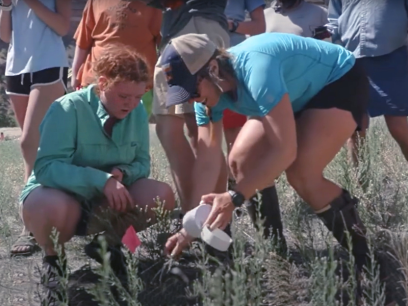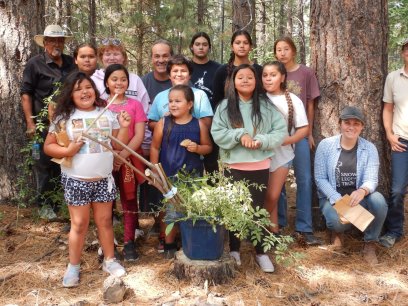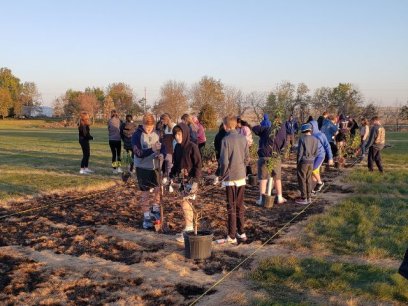
Just an hour outside of New York City, Teaneck Creek Park in Teaneck, New Jersey, is a much-beloved local park where nature, history, and art meet.
“It is a hidden gem, a true urban oasis. You can’t even imagine how much nature fits into this 46-acre plot,” said Van Trat, education manager at The Land Conservancy of New Jersey.
After completing a two-year, 20-acre habitat restoration project, a site that was once a garbage dump is now home to some of the newest freshwater wetlands in New Jersey. The park has also served as a living laboratory for students at neighboring schools, thanks to a partnership with NEEF.
Given the community’s easy access to the park, it was a natural fit for the Greening STEM approach, which combines place-based, three-dimensional, project-based, and community-based instruction with collaborative partnerships between educators, community stakeholders, and natural resource management agencies.

Adapting Greening STEM During the COVID-19 Pandemic and Beyond
During the 2019-2020 school year, NEEF partnered with Teaneck Creek Conservancy and Benjamin Franklin Middle School to give students real-world experience with environmental monitoring in the Teaneck watershed. Funding made possible by Samsung helped launch a Greening STEM project in February 2020 with an assembly, a professional development workshop for educators, and plans for weekly #WatershedWednesdays spent in the field to collect water samples and inventory macroinvertebrates.
Of course, we all remember what happened next: the pandemic shutdown. While challenging, the need for social distancing ultimately provided insights to help the school better accommodate all types of learners. For example, the shift to virtual learning showcased how some students excel in person, while others do better online.
“In education, we are always pivoting. Challenges are opportunities,” said Terrence Williams, principal at Benjamin Franklin Middle School.
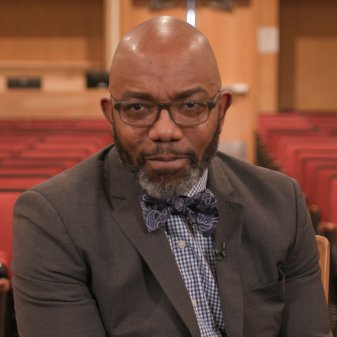
Educators initially continued water sampling at the creek and sharing videos with students. However, they soon realized that some of the experiences of being in the field simply cannot be duplicated virtually, and would have to be postponed until students could return to school in-person.
Phase II of the project was implemented during the 2021-2022 school year and expanded to include both Benjamin Franklin and Thomas Jefferson Middle Schools. Financial support from Bayer Fund relaunched the series of hands-on STEM learning activities focused on local watershed health that was developed collaboratively by school faculty and Teaneck Creek Conservancy staff. More than 730 students participated in the project during both phases.
“When we got back to the creek, it was like a reunion being back in the outdoors,” said Williams.
A Celebration of Positive Greening STEM Outcomes
A video series documented students’ enthusiasm throughout the project, aiming to inspire others to adopt the Greening STEM approach. While the videos are now several years old, Williams noted that the lessons they captured are timeless.
“The level of engagement was incredible,” said Williams. “These types of opportunities can lead to long-term, life-changing opportunities for students.”
Students were encouraged to bring their cell phones to the creek to document and share their work online through blogs and podcasts. The middle schools communicated about the project to the community using websites and social media. Teaneck Creek Conservancy also worked with the teachers involved in the project to help them share the results of the field work.
The project made a big impact on the educators as well. One of the teachers was so inspired by the grant that she went on to pursue her doctoral degree in a related field to get more involved in environmental education.
The Importance of Sharing Lessons Learned
While Trat has since moved on to a new role, she served as a key point of contact at Teaneck Creek Conservancy for the schools throughout both phases of the Greening STEM project. She offered some advice for other schools and parks that are interested in working together.
“I am taking a lot of lessons learned about facilitation and implementation with me in my current role,” said Trat. “I also learned a lot from the kids when they were completing the project by simply seeing them connect with nature.”
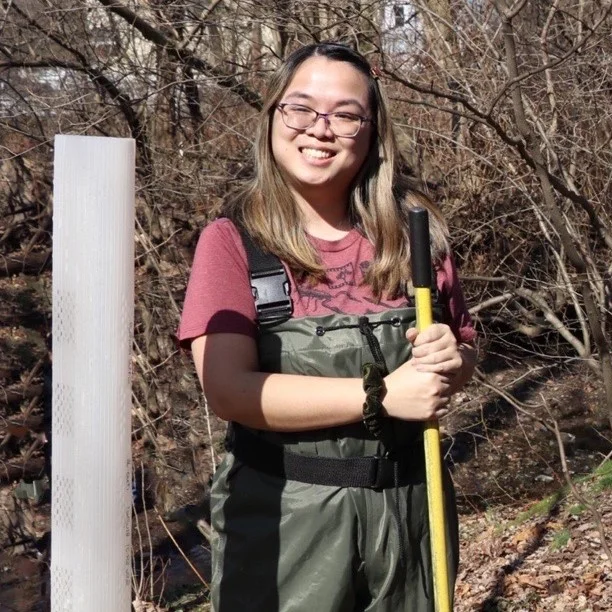
A crucial component of success for a Greening STEM implementation project is communicating with all of the involved stakeholders about the goals and timelines for the project. Due to the park’s limited staffing, Trat leaned on the board of directors and partner organizations and wasn’t afraid to ask for help or recommendations. And while there will be bumps in the road during any project, Williams said that the key is working with others who are dedicated to a common goal.
“Don’t underestimate the amount of work involved. It takes a lot of logistics and coordination between teachers and school administrators,” said Williams. “You do it knowing that at the end, it is going to be an amazing experience [for students].”
Ongoing Collaboration in Support of Environmental Education
Establishing an ecosystem of local partnerships was one of the major goals of the Teaneck Creek Greening STEM project:
- Teaneck Creek Conservancy provided the watershed and technical expertise.
- Benjamin Franklin and Thomas Jefferson Middle Schools brought students, faculty, and developed learning activities.
- Hackensack Riverkeeper offered field support and volunteer educators.
- The Suez water utility company (now Veolia) provided a facility tour.
- The Bergen County Department of Parks and Recreation shared access to additional public land sites and received the project’s findings.
While the grant from NEEF formally ended in 2022, the collaboration continues today. Williams served as a board member for Teaneck Creek Conservancy for several years and remains a champion for the park to this day. In December 2023, a “Naturescapes” exhibit at the Teaneck Public Library featured art and poetry from Benjamin Franklin Middle School students inspired by their time in the park. The exhibit was made possible with funds from Veolia and the Bergen County Division of Cultural & Historic Affairs, a partner of the New Jersey State Council on the Arts.
“We continue to think of Teaneck Creek as a classroom,” said Williams. “The exhibit was a chance to merge literacy and art.”

The middle schools also continue to look for new opportunities and new partnerships in environmental education beyond the creek. Trat is working with Williams to explore additional opportunities for students to get outside and experience citizen science activities on New Jersey’s land preserves through her current role at The Land Conservancy of New Jersey.
How to Bring Greening STEM to Your School
The lessons learned from Teaneck Creek’s Greening STEM project can be applied to other schools and watersheds.
Williams offered this advice for educators: “Don’t be afraid to push your principal to do something different. Greening STEM increases learning outcomes.”
If you are interested in launching a similar activity, start by exploring nearby public land or water sites to identify a good fit for an inquiry-based, hands-on field experience for students. NEEF offers a variety of Greening STEM resources for K-12 educators and parents:
- Greening STEM Hub: Resources to help you get started with a Greening STEM project, including examples of activities, lessons, and curricula.
- Greening STEM Spaces: Learn from real-life examples about how outdoor spaces of all types provide learning opportunities.
- Greening STEM Projects: Explore successful Greening STEM projects around the country made possible by NEEF.
NEEF continues to pursue new avenues for expanding the Greening STEM approach through our federal land management partners. For example, in June 2024, NEEF announced the awardees of the 2024-2025 Bureau of Land Management Greening STEM Grant, which will design and deliver STEM programming at BLM field sites across the country. Sign up for our email distribution list to be notified of future Greening STEM grant opportunities from NEEF.
